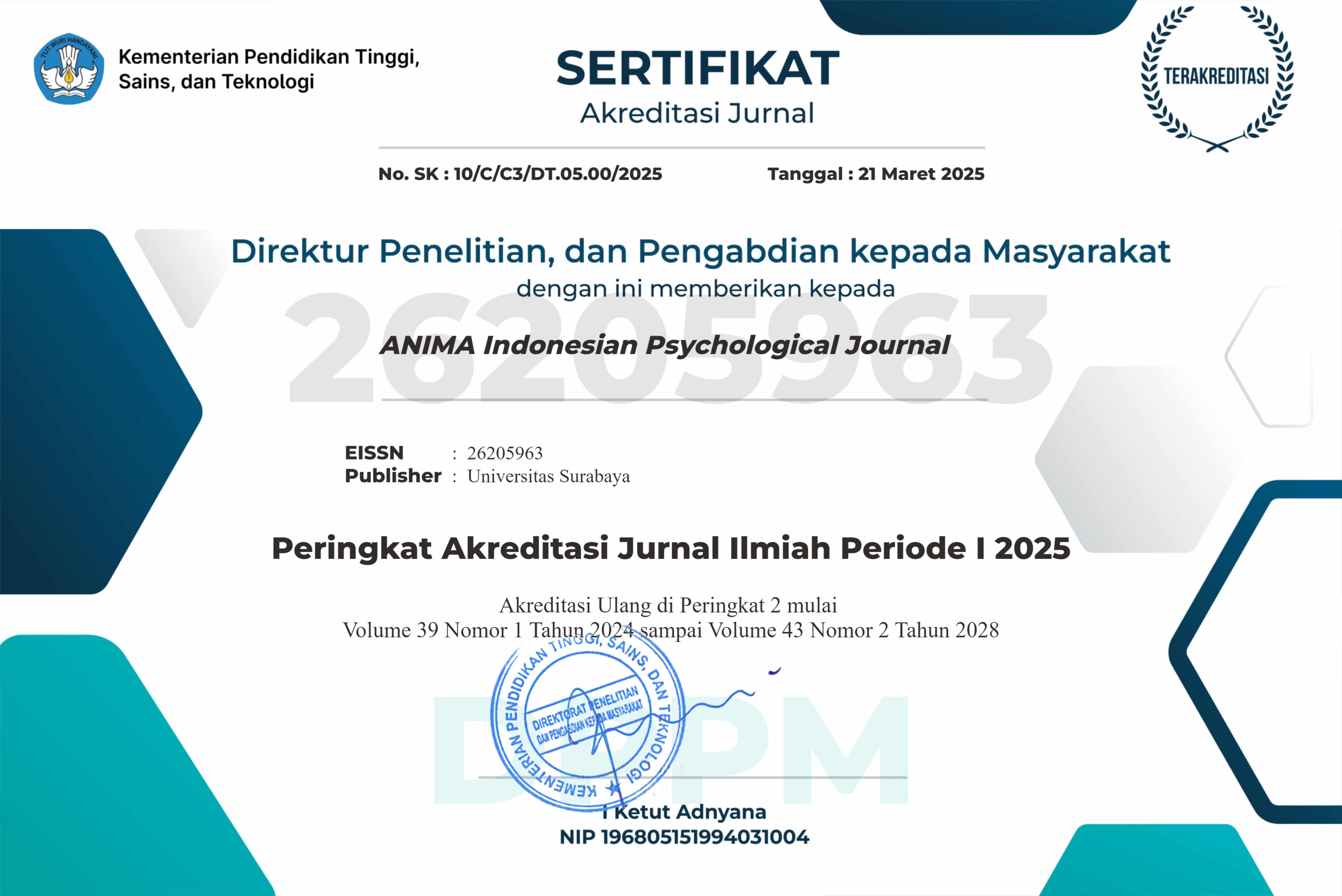Dynamics of the Emergence of Upstander Behavior in the Posttraumatic Growth (PTG) Process in Survivors of Sexual Violence
 Abstract Views:
491 times
Abstract Views:
491 times
 PDF - Full Text Downloads:
317 times
PDF - Full Text Downloads:
317 times
Abstract
Penyintas kekerasan seksual yang mengalami proses posttraumatic growth (PTG) berpotensi menunjukkan perilaku upstander. Perilaku tersebut dapat memperkuat proses posttraumatic growth (PTG) yang dialami, sehingga memperoleh pencapaian optimal. Studi ini bertujuan mengidentifikasi pada tahap apa dalam proses posttraumatic growth (PTG) perilaku upstander muncul, memahami proses terjadinya, serta mengevaluasi dampaknya. Studi ini merupakan studi penelitian kualitatif dengan analisis kasus. Pengumpulan data menggunakan panduan wawancara posttraumatic growth (PTG) dan Theory of Planned Behavior (TPB). Screening test dilakukan menggunakan Global Psychotrauma Screen (GPS) untuk memilih partisipan berdasarkan usia saat mengalami kekerasan seksual, serta ketangguhan dan keberfungsian diri dalam satu bulan terakhir. Studi ini melibatkan tiga partisipan yang mengalami kekerasan seksual di atas usia sembilan tahun, melaporkan ketangguhan dan keberfungsian diri, serta pernah melakukan perilaku upstander. Pengolahan data menggunakan analisis tematik. Hasil studi ini menunjukkan bahwa perilaku upstander muncul pada tahap automatic and intrusive rumination, manage emotional distress, dan deliberate rumination dalam proses posttraumatic growth (PTG). Perilaku upstander pada tahap automatic and intrusive rumination dapat menimbulkan konsekuensi negatif yang tidak disengaja, berdasarkan pengalaman partisipan studi. Sebaliknya, pada tahap manage emotional distress dan deliberate rumination dapat mendukung pencapaian posttraumatic growth (PTG). Perbedaan situasi tersebut sangat dipengaruhi oleh norma subjektif mengenai perilaku dan adanya atau tidak adanya kontrol perilaku yang dirasakan serta kontrol aktual yang memadai.
Downloads
References
Aigner, C. J. (2022). Love or fear? The please/appease survival response: Interrupting the cycle of trauma [Unpublished Master’s thesis, Simon Fraser University]. Simon Fraser University - Summit Research Repository. https://summit.sfu.ca/item/35736
Ajzen, I. (n.d.). Constructing a Theory of Planned Behavior Questionnaire. University of Massachusetts Amherst. https://people.umass.edu/aizen/pdf/tpb.measurement.pdf
Ajzen, I. (1985). From intentions to actions: A Theory of Planned Behavior. In J. Kuhl, & J. Beckmann (Eds.), Action control: From cognition to behavior (pp. 11-39). Springer. https://doi.org/10.1007/978-3-642-69746-3_2
Ajzen, I. (2019). Theory of Planned Behavior with background factors. University of Massachusetts Amherst. https://people.umass.edu/aizen/tpb.background.html
Ajzen, I. (2020). The Theory of Planned Behavior: Frequently asked questions. Human Behavior and Emerging Technologies, 2(4), 314-324. https://doi.org/10.1002/hbe2.195
Amalia, F., & Darojat, A. A. (2022). Peran dukungan sosial keluarga dalam proses penerimaan diri pada remaja korban kekerasan seksual [The role of family social support in the self-acceptance process of adolescent sexual violence survivors]. Al-Huwiyah: Journal of Woman and Children Studies, 2(2), 101-113. https://doi.org/10.24042/jwcs.v2i2.15269
Ayu, T. (2021). Lakukan 5D jika melihat ada pelecehan seksual [Do 5D if you see sexual harassment]. Tempo. https://www.tempo.co/politik/lakukan-5d-jika-melihat-ada-pelecehan-seksual-478210
Calhoun, L. G., & Tedeschi, R. G. (Eds.). (2006). Handbook of posttraumatic growth: Research & practice (1st ed.). Lawrence Erlbaum Associates Publishers. https://doi.org/10.4324/9781315805597 | https://psycnet.apa.org/record/2006-05098-000
Calhoun, L. G., & Tedeschi, R. G. (2013). Posttraumatic growth in clinical practice (1st ed.). Routledge/Taylor & Francis Group. https://psycnet.apa.org/record/2012-34294-000 | https://www.routledge.com/Posttraumatic-Growth-in-Clinical-Practice/Calhoun-Tedeschi/p/book/9780415645300?srsltid=AfmBOookieoAOzU6TldmF_c6Q-vQnrFarwIuV-kiEr0fTr7dTQuI99LJ
Clark, J. L., Perera, T., Pun, R., Kim, M., Twardowski, K., & Enoch, T. (2022). Equity and inclusion panel. The Serials Librarian, 82(1-4), 13-16. https://doi.org/10.1080/0361526X.2022.2028502
Creswell, J. W., (2012). Educational research: Planning, conducting, and evaluating quantitative and qualitative research (4th ed.). Pearson Education, Inc.. https://www.pearson.com/en-us/subject-catalog/p/educational-research-planning-conducting-and-evaluating-quantitative-and-qualitative-research/P200000010566/9780138173784
Creswell, J. W., & Creswell, J. D. (2018). Research design: Qualitative, quantitative, and mixed methods approaches (5th ed.). SAGE Publications, Inc.. https://uk.sagepub.com/en-gb/eur/research-design/book270550
Draucker, C. B., & Stern, P. N. (2000). Women's responses to sexual violence by male intimates. Western Journal of Nursing Research, 22(4), 385-406. https://doi.org/10.1177/019394590002200403
Fayaz, I. (2023). Systematic review of posttraumatic growth from sexual assault in women. Journal of Loss and Trauma: International Perspectives on Stress & Coping, 29(3), 291-312. https://doi.org/10.1080/15325024.2023.2254240
Feist, J., Feist, J. G., & Roberts, T. -A. (2017). Teori kepribadian (Edisi ke-8) [Theory of personality (8th ed.)] (R. A. H. D. Pertiwi, Trans.). Salemba Humanika. https://penerbitsalemba.com/buku/10-0104-teori-kepribadian-1-e8
Grossman, F. K., Sorsoli, L., & Kia-Keating, M. (2006). A gale force wind: Meaning making by male survivors of childhood sexual abuse. American Journal of Orthopsychiatry, 76(4), 434-443. https://doi.org/10.1037/0002-9432.76.4.434
Guggisberg, M., Bottino, S., & Doran, C. M. (2021). Women’s contexts and circumstances of posttraumatic growth after sexual victimization: A systematic review. Frontiers in Psychology, 12: 699288. Frontiers Media S.A. https://doi.org/10.3389/fpsyg.2021.699288
Hidayat, D. R. (2011). Teori dan aplikasi psikologi kepribadian dalam konseling (Edisi ke-1) [Theories and application of personality psychology in counseling (1st ed.)]. Ghalia Indonesia.
Irwanto, & Kumala, H. (2020). Memahami trauma: Dengan perhatian khusus pada masa kanak-kanak [Understanding trauma: With special attention on childhood]. Gramedia Pustaka Utama. https://www.gramedia.com/products/memahami-trauma-dengan-perhatian-khusus-pada-masa-kanak-kanak-1?srsltid=AfmBOoobRG6hUI5X3p1HpwZtMcQ0bNv4OKAX9E7aXtFOO1OygYA5mx04
Kementerian Pemberdayaan Perempuan dan Perlindungan Anak Republik Indonesia [The Ministry of Women Empowerment and Child Protection of the Republic of Indonesia]. (2024). Perbandingan jumlah kasus kekerasan [Comparison of number of violence cases]. Sistem Informasi Online Perlindungan Perempuan dan Anak (SIMFONI PPA). https://kekerasan.kemenpppa.go.id/ringkasan
Kerlin, A. M., & Sosin, L. S. (2017). Recovery from childhood abuse: a spiritually integrated qualitative exploration of 10 women’s journeys. Journal of Spirituality in Mental Health, 19(3), 189-209. https://doi.org/10.1080/19349637.2016.1247411
Levin, Y., Lev Bar-Or, R., Forer, R., Vaserman, M., Kor, A., & Lev-Ran, S. (2021). The association between type of trauma, level of exposure and addiction. Addictive Behaviors, 118: 106889. https://doi.org/10.1016/j.addbeh.2021.106889
Olff, M., Bakker, A., Frewen, P., Aakvaag, H., Ajdukovic, D., Brewer, D., Elmore Borbon, D. L., Cloitre, M., Hyland, P., Kassam-Adams, N., Knefel, M., Lanza, J. A., Lueger-Schuster, B., Nickerson, A., Oe, M., Pfaltz, M. C., Salgado, C., Seedat, S., Wagner, A., Schnyder, U., & Global Collaboration on Traumatic Stress (GC-TS). (2020). Screening for consequences of trauma–an update on the global collaboration on traumatic stress. European Journal of Psychotraumatology, 11(1): 175504. https://doi.org/10.1080/20008198.2020.1752504
Park, C. L., & Ai, A. L. (2006). Meaning making and growth: New directions for research on survivors of trauma. Journal of Loss and Trauma: International Perspectives on Stress & Coping, 11(5), 389-407. https://doi.org/10.1080/15325020600685295
Pemerintah Republik Indonesia [The Government of the Republic of Indonesia]. (2022). Undang-Undang Republik Indonesia Nomor 12 Tahun 2022 Tentang Tindak Pidana Kekerasan Seksual [The Regulation of the Republic of Indonesia Number 12 Year 2022 Regarding Criminal Acts of Sexual Violence]. Jaringan Dokumentasi dan Informasi Hukum (JDIH) Komisi Yudisial. https://jdih.komisiyudisial.go.id/frontend/detail/4/281#:~:text=Abstrak-,Undang%2DUndang%20Nomor%2012%20Tahun%202022%20Tentang%20Tindak%20Pidana%20Kekerasan,bentuk%20tindak%20pidana%20kekerasan%20seksual.
Primasari, I., Hoeboer, C., Bakker, A., & Olff, M. (2020-2021a). Validation study of three new Indonesian questionnaires for assessing resilience and trauma-related symptoms in Indonesian undergraduate students. The Open Science Framework. https://osf.io/taf34/
Primasari, I., Hoeboer, C., Bakker, A., Olff, M. (2020-2021b). Statistical analysis plan (SAP) validation study of Global Psychotrauma Screen (GPS) for assessing trauma related symptoms in Indonesian undergraduate students. The Open Science Framework. https://osf.io/nrmuy
Right To Be. (n.d.). The 5Ds of bystander intervention. Right To Be. https://righttobe.org/guides/bystander-intervention-training/
Rossa, V., & Putri, F. I. (2020). Hollaback Jakarta, ‘ruang aman’ lawan pelecehan seksual [Hollaback Jakarta, ‘safe space’ to fight sexual harassment]. Suara. https://www.suara.com/lifestyle/2020/03/12/135454/hollaback-jakarta-ruang-aman-lawan-pelecehan-seksual?page=all
Stake, R. E. (1995). The art of case study research. SAGE Publications, Inc.. https://psycnet.apa.org/record/1995-97834-000 | https://us.sagepub.com/en-us/nam/the-art-of-case-study-research/book4954
Stidham, A. W., Draucker, C. B., Martsolf, D. S., & Mullen, L. P. (2012). Altruism in survivors of sexual violence: The typology of helping others. Journal of the American Psychiatric Nurses Association, 18(3), 146-155. https://doi.org/10.1177/1078390312440595
Strauss Swanson, C., & Szymanski, D. M. (2020). From pain to power: An exploration of activism, the #Metoo movement, and healing from sexual assault trauma. Journal of Counseling Psychology, 67(6), 653-668. https://doi.org/10.1037/cou0000429
Sweeney, A., Filson, B., Kennedy, A., Collinson, L., & Gillard, S. (2018). A paradigm shift: Relationships in trauma-informed mental health services. British Journal of Psychiatry (BJPsych) Advances, 24(5), 319-333. https://doi.org.10.1192/bja.2018.29
Tedeschi, R. G., Shakespeare-Finch, J., Taku, K., & Calhoun, L. G. (2018). Posttraumatic growth: Theory, research, and applications. Routledge. https://www.routledge.com/Posttraumatic-Growth-Theory-Research-and-Applications/Tedeschi-Shakespeare-Finch-Taku/p/book/9781138675049?srsltid=AfmBOor1JmY4NxO2OLUhXaWouT9MDLXKdufQhWtpvWkBKLYeGUBH19kI
Thomas, S. P., & Hall, J. M. (2008). Life trajectories of female child abuse thriving in adulthood. Qualitative Health Research, 18(2), 149-166. https://doi.org/10.1177/1049732307312201
Ulloa, E., Guzman, M. L., Salazar, M., & Cala, C. (2016). Posttraumatic growth and sexual violence: A literature review. Journal of Aggression, Maltreatment & Trauma, 25(3), 286-304. https://doi.org/10.1080/10926771.2015.1079286
Volgin, R. N., Shakespeare-Finch, J., & Shochet, I. M. (2019). Posttraumatic distress, hope and growth in survivors of commercial sexual exploitation in Nepal. Traumatology, 25(3), 181-188. https://doi.org/10.1037/trm0000174
Wright, M. O., Crawford, E., & Sebastian, K. (2007). Positive resolution of childhood sexual abuse experiences: The role of coping, benefit-finding and meaning making. Journal of Family Violence, 22, 597-608. https://doi.org/10.1007/s10896-007-9111-1
Yin, R. K. (2017). Case study research and applications: Design and methods (6th ed.). SAGE Publications, Inc.. https://us.sagepub.com/en-us/nam/case-study-research-and-applications/book250150
Yin, R. K. (2011). Applications of case study research (3rd ed.). SAGE Publications, Inc.. https://us.sagepub.com/en-us/nam/applications-of-case-study-research/book235140

This work is licensed under a Creative Commons Attribution-NonCommercial-ShareAlike 4.0 International License.

This work is licensed under a Creative Commons Attribution-NonCommercial-ShareAlike 4.0 International License.
Articles published in ANIMA are licensed under a Creative Commons Attribution-NonCommercial-ShareAlike 4.0 International license. You are free to copy, transform, or redistribute articles for any lawful, non-commercial purpose in any medium, provided you give appropriate credit to ANIMA and the original Author(s), link to the license, indicate if changes were made, and redistribute any derivative work under the same license.
Copyright on articles is retained by the respective Author(s), without restrictions. A non-exclusive license is granted to ANIMA to publish the article and identify itself as its original publisher, along with the commercial right to include the article in a hardcopy issue for sale to libraries and individuals.
By publishing in ANIMA, Author(s) grant any third party the right to use their article to the extent provided by the Creative Commons Attribution-NonCommercial-ShareAlike 4.0 International license.

 DOI:
DOI:



